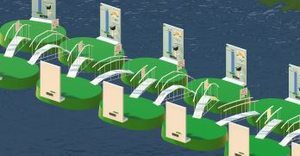Information
- Publication Type: Master Thesis
- Workgroup(s)/Project(s):
- Date: April 2020
- Date (Start): 20. October 2019
- Date (End): 30. April 2020
- Second Supervisor: Khrystyna Vasylevska
- Diploma Examination: 30. April 2020
- Open Access: yes
- First Supervisor: Hannes Kaufmann
Abstract
Virtual reality (VR) promises boundless potential for experiences. Yet, due to technical restrictions, current VR experiences are often limited in many ways and incomparable to their real-world counterparts. Walkable smooth uneven surfaces are inherent to reality but lacking in VR. At the same time, VR enables the alteration and manipulation of perception, o˙ering tools for reshaping the experience. In this thesis, we explore the possibility of simulating walkable smooth uneven surfaces in VR via a multi-sensory stimulation approach. We examine human height and slant perception and incorporate our findings into a multi-modal approach by combining visual manipulations, haptic and vibrotactile stimuli. Our approach is realized by constructing physical bridge props and creating a complex software application to introduce multi-sensory stimuli to the user. The simulation is evaluated in two user studies, each focusing on one of two di˙erently shaped physical bridge props. In the studies, we evaluate the feasibility of a flat and an upward curved prop for the simulation of di˙erent virtual surface heights. The data collected during the studies is subjected to a qualitative and quantitative analysis. Our results suggest that the use of a curved prop enables the convincing simulation of significantly higher uneven surfaces than the actual height of the prop. The haptic feedback of the curved surface and the proprioceptive cues of actual vertical traversal facilitate user provided height and slant estimations to be closer to the values suggested by the visual cues. The use of a flat prop is less realistic and leads to height and slant underestimations, despite the simulated visual height and slant cues. However, a flat surface might be still used to simulate indentations and protrusions with smaller height di˙erences.Additional Files and Images
Weblinks
No further information available.BibTeX
@mastersthesis{Kovacs_2020,
title = "VR Bridges: An Approach to Simulating Uneven Surfaces in VR",
author = "B\'{a}lint Istvan Kov\'{a}cs",
year = "2020",
abstract = "Virtual reality (VR) promises boundless potential for
experiences. Yet, due to technical restrictions, current VR
experiences are often limited in many ways and incomparable
to their real-world counterparts. Walkable smooth uneven
surfaces are inherent to reality but lacking in VR. At the
same time, VR enables the alteration and manipulation of
perception, o˙ering tools for reshaping the experience. In
this thesis, we explore the possibility of simulating
walkable smooth uneven surfaces in VR via a multi-sensory
stimulation approach. We examine human height and slant
perception and incorporate our findings into a multi-modal
approach by combining visual manipulations, haptic and
vibrotactile stimuli. Our approach is realized by
constructing physical bridge props and creating a complex
software application to introduce multi-sensory stimuli to
the user. The simulation is evaluated in two user studies,
each focusing on one of two di˙erently shaped physical
bridge props. In the studies, we evaluate the feasibility of
a flat and an upward curved prop for the simulation of
di˙erent virtual surface heights. The data collected during
the studies is subjected to a qualitative and quantitative
analysis. Our results suggest that the use of a curved prop
enables the convincing simulation of significantly higher
uneven surfaces than the actual height of the prop. The
haptic feedback of the curved surface and the proprioceptive
cues of actual vertical traversal facilitate user provided
height and slant estimations to be closer to the values
suggested by the visual cues. The use of a flat prop is less
realistic and leads to height and slant underestimations,
despite the simulated visual height and slant cues. However,
a flat surface might be still used to simulate indentations
and protrusions with smaller height di˙erences.",
month = apr,
address = "Favoritenstrasse 9-11/E193-02, A-1040 Vienna, Austria",
school = "Research Unit of Computer Graphics, Institute of Visual
Computing and Human-Centered Technology, Faculty of
Informatics, TU Wien",
URL = "https://www.cg.tuwien.ac.at/research/publications/2020/Kovacs_2020/",
}

 Image
Image Master Thesis
Master Thesis

